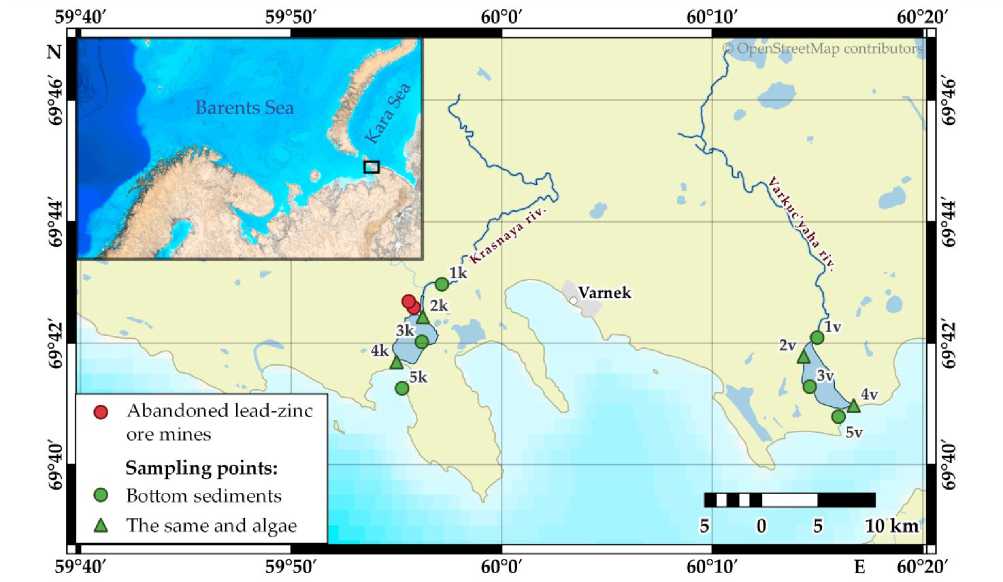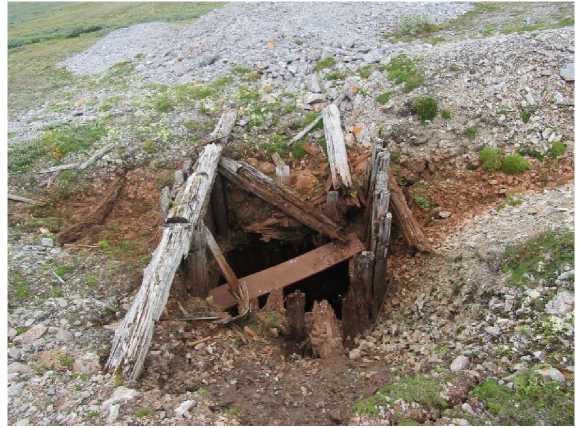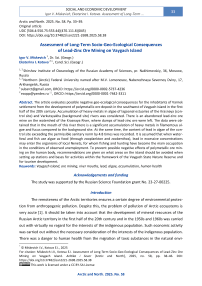Assessment of Long-Term Socio-Geo-Ecological Consequences of Lead-Zinc Ore Mining on Vaygach Island
Автор: Miskevich I.V., Kotova E.I.
Журнал: Arctic and North @arctic-and-north
Рубрика: Social and economic development
Статья в выпуске: 58, 2025 года.
Бесплатный доступ
The article evaluates possible negative geo-ecological consequences for the inhabitants of Varnek settlement from the development of polymetallic ore deposit in the southwest of Vaygach Island in the first half of the 20th century. Accumulation of heavy metals in algae of lagoonal estuaries of the Krasnaya (control site) and Varkutsyakha (background site) rivers was considered. There is an abandoned lead-zinc ore mine on the watershed of the Krasnaya River, where dumps of lead-zinc ore were left. The data were obtained that in the mouth of this river there is a significant accumulation of heavy metals in filamentous algae and fucus compared to the background site. At the same time, the content of lead in algae of the control site exceeding the permissible sanitary norm by 4.8 times was recorded. It is assumed that when waterfowl and fish use algae as food (through zooplankton and zoobenthos), lead in excessive concentrations may enter the organisms of local Nenets, for whom fishing and hunting have become the main occupation in the conditions of observed unemployment. To prevent possible negative effects of polymetallic ore mining on the human body, recommendations are given on what areas on the island should be avoided when setting up stations and bases for activities within the framework of the Vaygach State Nature Reserve and for tourism development.
Vaygach Island, ore mining, river mouths, lead, algae, accumulation, human health
Короткий адрес: https://sciup.org/148330874
IDR: 148330874 | УДК: [504.4:550.75:553.44](470.111.8)(045) | DOI: 10.37482/issn2221-2698.2025.58.38
Текст научной статьи Assessment of Long-Term Socio-Geo-Ecological Consequences of Lead-Zinc Ore Mining on Vaygach Island
DOI:
The remoteness of the Arctic territories ensures a certain degree of environmental protection from anthropogenic pollution. Despite this, the problem of pollution of Arctic ecosystems is very acute [1]. It should be taken into account that the development of mineral resources of the Russian Arctic territory in the first half of the 20th century and in the 1950s and 1960s was carried out with virtually no regard for the interests of the indigenous population. Such economic activity was carried out without the necessary consideration of the interests of the indigenous population. There was a danger to human health from the migration of toxic substances in the natural envi- ronment. They entered the human body through the consumption of meat and fishery products, berries, mushrooms, as well as snow and ice for drinking with a high content of anthropogenic aerosols. In this regard, the greatest attention was paid to assessing the impact of radionuclides on the population of the Russian North during the nuclear tests on Novaya Zemlya [2–3]. However, for other toxic substances, including a number of heavy metals, research in this area has been conducted on an extremely limited scale. Currently, the Russian Arctic has a large number of abandoned or mothballed mining sites developed several decades ago without any reclamation. Their impact on the health of residents of the Russian North has been poorly studied, and the existing researches on this topic are descriptive in nature without mentioning specific levels of toxic substances in the natural environment. Current knowledge of Arctic estuaries is mostly based on studies of several large systems [4].
In the Nenets Autonomous Okrug, the mining of lead-zinc ores could cause possible negative consequences for the Nenets, the indigenous inhabitants of the Varnek settlement. It was carried out in the period from 1931 to 1934 in the southwest of Vaygach Island. The Razdelnyy mine, part of the Gulag system, operated here and was the first place in the Arctic for industrial extraction of polymetallic ores. The volume of their extraction amounted to about 11 thousand tons of ore [5]. In 1935, ore extraction was stopped due to the flooding of mines with groundwater as there was no system of pumping water from the mines in those years. The deposit was developed during the period of short-term warming in the western sector of the Russian Arctic, observed in the 1920–1940s [6], and most likely this factor was not taken into account when calculating the level and volume of groundwater. In addition, exploratory shafts and trenches for justifying the extraction of copper ore are located in the area of the Dyrovataya Bay, and for justifying the extraction of copper-zinc ores — in the area of the Dolgaya Bay in the northern part of Vaygach [7]. Extraction and exploration of polymetallic ores was carried out without any environmental protection measures or reclamation activities.
The threat to human health in the presence of high concentrations of heavy metals in the environment usually occurs when they enter the human body through food. Fish (omul, char, grayling, pink salmon, whitefish, Arctic flounder) and game (various species of geese and ducks) play a major role in the diet of the residents of Varnek settlement. In recent years, venison has been losing its position in this respect due to the small number of reindeer grazing on Vaygach and the increasing cost of their meat. Lead, zinc and other heavy metals enter the tissues of fish and waterfowl when they consume contaminated hydrobionts: zooplankton and zoobenthos. Accumulation of toxic substances in zooplankton and zoobenthos occurs when they consume products of destruction of algae and aquatic vegetation. Geese and herbivorous ducks can also consume filamentous algae and aquatic vegetation.
Heavy metals are transported from polymetallic ore mining sites through a network of drainage micro-watersheds. They then flow into the rivers and streams of Vaygach Island and waters of the Barents Sea. Maximum accumulation of heavy metals in aquatic ecosystems during their transit from land to sea, according to the model of Academician A.P. Lisitsyn [8], should be observed at the coagulation-sorption stage of the marginal filter in the frontal section in the mixing zone of river and sea waters. The maximum accumulation of heavy metals in bottom sediments and aquatic vegetation should occur at the localization area of this frontal section.
In recent years, interest in Arctic resources has increased. Projects for the development of Arctic deposits, and not only oil and gas ones, are emerging. For example, the Pavlovskoe deposit on Yuzhnyy Island, Novaya Zemlya archipelago, is one of the largest lead and zinc deposits, and is also rich in silver. The project for the development of the deposit, which will be carried out by the First Ore Mining Company, a subsidiary of Rosatom, has already successfully passed an environmental assessment. In order to implement the principle of rational nature management, it is necessary to have information on the state and possible changes in the environment not only of the territory to be developed, but also of the surrounding areas. The results obtained in this work may be useful in assessing the consequences of lead-zinc ore mining in the Arctic.
Materials and methods
In the summer of 2023, the staff of the North-West Branch of the Shirshov Institute of
Oceanology of the Russian Academy of Sciences conducted comprehensive hydrological, hydrochemical and hydrobiological expeditionary studies of two lagoon mouths of the small rivers Krasnaya and Varkutsyakha (Fig. 1). They are located in the southwestern part of Vaygach Island at approximately the same distance from the village of Varneka (about 5 km) and flow into the
Yugorsky Shar Strait, which separates the Barents and Kara Seas.

Fig. 1. Map-scheme of the location of the work areas.
Algae sampling was carried out at two stations at each river mouth. The first station was located at the river boundaries of the estuarine lagoons. The second station was located at the sea boundaries of the lagoons.
After sampling, the algae samples were dried and crushed. Concentrations of heavy metals were determined using the method of PND F 16.2.2:2.3.71-2011 at the Center for collective use of scientific equipment “Arctic” of the Northern (Arctic) Federal University named after M.V. Lomonosov.
For measuring water level fluctuations at semi-daily stations, water gauges with reference to the conditional zero point of the station were used. For observations of water temperature, salinity (mineralization) and oxygen, a multi-parameter liquid analyzer Multi 3420 from WTW (Germany) was used).
Results and discussion
In the watershed area of the Krasnaya River, industrial mining of lead-zinc ores was carried out in the last century. In 2023, two destroyed mines (Fig. 2) with waste dumps of ore and 10 trenches (micro-quarries) 5–19 m long each were discovered at the lead-zinc ore mining site. Drainage (storm water) and groundwater flow from the territory of the destroyed mines into the Payhayakhato River, which in turn flows into the mouth of the Krasnaya River.
There was no economic activity in the Varkutsyakha River watershed area. This river was considered as a background river.

Fig. 2. Destroyed mine with waste dumps of lead-zinc ore in the Krasnaya River watershed area (July 2023).
Water salinity at the river boundaries of the estuarine lagoons (the first observation station) during the tidal cycle ranged from 18.1–24.8‰ at the mouth of the Krasnaya River and 7.8– 23.3‰ at the mouth of the Varkutsyakha River. Water salinity at the sea boundaries of the lagoons (the second observation station) during the tidal cycle remained practically unchanged and was 25.2‰ at the mouth of the Krasnaya River and 25.4‰ at the mouth of the Varkutsyakha River.
Information on the content of heavy metals in algae samples in the considered river mouths is given in Table 1.
Table 1
Heavy metal content in algae of the river mouths of Vaygach Island, summer 2023
|
Distance from the sea boundary of the river mouth |
Macrophyte species |
Metal concentrations, mg/kg |
|||||
|
As |
Cu |
Mn |
Ni |
Pb |
Zn |
||
|
The mouth of the Krasnaya River |
|||||||
|
1 km |
Fucus distichus |
15.0 |
0.89 |
99 |
4.3 |
0.34 |
13 |
|
3 km |
Ulva prolifera |
3.4 |
2.5 |
830 |
4.7 |
2.4 |
50 |
|
The mouth of the Varkutsyakha River |
|||||||
|
1 km |
Fucus distichus |
5.6 |
1.1 |
360 |
4.0 |
<0.25 |
20 |
|
3 km |
Ulva prolifera |
8.7 |
1.4 |
440 |
4.0 |
0.46 |
31 |
According to the data obtained, a noticeable excess of all the studied metals, with the exception of arsenic, in the filamentous estuarine algae Ulva prolifera is observed at the mouth of the Krasnaya River (control site). However, the arsenic content in the seaweed at the mouth of the Krasnaya River (control site) was significantly higher than at the mouth of the Varkutsyakha River (background site). It should be noted that the maximum difference between the metal content in the algae at the background and control sites was observed for lead, which is part of the mined polymetallic ores. As a result, it should be assumed that we have recorded long-term negative consequences of lead-zinc ore mining for the ecosystem of the Krasnaya River, which could have a negative impact on the health of the residents of the Varnek settlement, but they avoid visiting this site for fishing due to the lack of fish stocks. At the same time, there is a fishing hut at the mouth of the Varkutsyakha River, and they annually catch fish (char, omul, in odd years — pink salmon) and hunt here. It should be taken into account that fishing and hunting have become the main occupation for the local Nenets in conditions of high unemployment.
Lead and other metals enter the ore site in two ways. It can occur due to the flow of highly acidified drainage waters from numerous ore dumps, not removed for processing after the mines stopped working, into the mouth of the Krasnaya River. Acidified rain and melt water contribute to the gradual leaching of lead and other metals from ore dumps into surface and ground waters.
According to the data of the snow cover studies of Vaygach, conducted in March 2024, the snow on the island was strongly acidified: pH ranged between 4.38 and 4.80, with the lower range of the maximum permissible pH for surface water being 6.5.
The second way of migration of significant concentrations of metals into the estuary of the Krasnaya River is the discharge of groundwater from the site of the developed polymetallic ore deposit. It is increasing due to the climate warming in the Arctic in recent decades. According to some forecasts, this process may continue in the coming decades [9]. At the ore mining site under consideration, the destruction of permafrost rocks enriched with lead and zinc is increasing due to the penetration of warm air through the destroyed mines.
The maximum permissible lead content in algae, according to the Technical Regulations of Customs Union 1, is 0.5 mg/kg. It turns out that the recorded maximum concentration of lead in algae of the Krasnaya River mouth exceeds the above-mentioned standard 4.8 times.
The Nenets do not use algae as food, but it is possible that they may ingest excess lead concentrations in the area of the island under consideration while eating fish and waterfowl that consume these algae or aquatic organisms. According to hygienic standards, lead has the first hazard class: when it enters the human body, it increases blood pressure, disrupts the functioning of the nervous system, liver, kidneys, reduces reproductive function, and can affect all parts of the brain.
Conclusion
Thus, in the areas of polymetallic ore mining on Vaygach Island, increased levels of heavy metals may be observed in various types of aquatic flora and fauna. However, their high concentrations are likely to be observed only in localized areas with characteristic dimensions of tens to hundreds of meters.
In general, the problem raised is not of particular relevance to the permanent residents of Varnek village and their relatives from the mainland who come here for vacation. Nevertheless, given the potential involvement of the local population in activities associated with the Vaygach State Nature Reserve and the planned expansion of tourism on the island, it is possible that they will stay in the polymetallic ore mining areas for a relatively long period of time (several weeks or more) each year.
In order to eliminate negative consequences of staying in such areas, it is recommended not to create any permanent facilities and bases (camps) at the mouths of rivers and near lakes where drainage runoff from the areas of exploration and industrial mining of polymetallic ores flows.
The following sites should be referred to them:
-
• the coast of the peninsula on which the Razdelnyy mine was located (the area of Cape Razdelnyy in the Yugorsky Shar Strait);
-
• the mouth of the Krasnaya River;
-
• Lake Paipahto;
-
• the mouth of the Krasnyy Yar River;
-
• the mouth of the Yangorey River;
-
• Lake Heheto;
-
• the coast of the Dyrovataya Bay.
It should be noted that the planned organization of a tourist base in the northeast of Vaygach in the area of Bolvanskiy Nos Cape (on the site of the former border outpost) will not be endangered by the migration of heavy metals into the environment.


